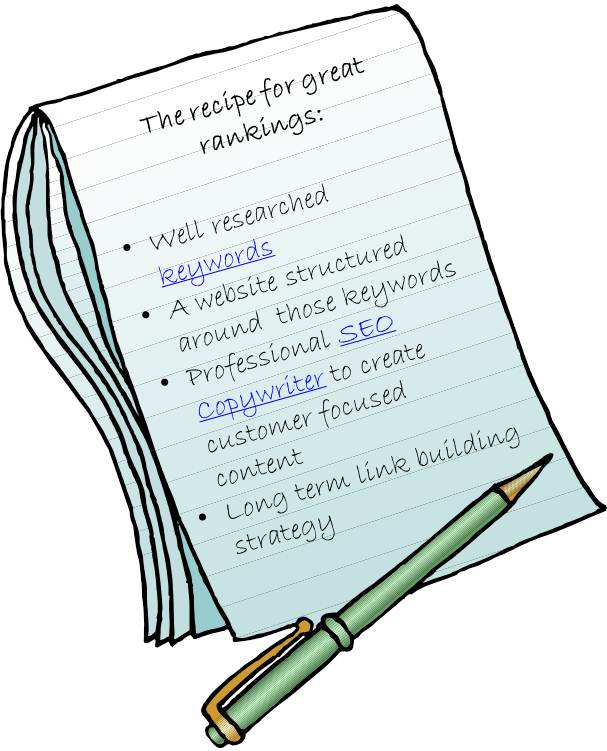Entries from August 2011 ↓
August 31st, 2011 — search engine optimisation, seo, SEO copywriter, seo website copywriter, website copywriter, website copywriting

From that list of ingredients, this post will look at the power of SEO copywriting.
When done well it will help your search engine rankings, attract readers and convert them into sales.
Done badly it could harm your rankings, repel customers and won’t convert a sausage.
So how can you make sure you get it right?
5 signs of good SEO copy
1. Write for your reader
There is a popular misconception that SEO copy has to be written for the search engines.
Wrong.
When writing your copy, always write it for your reader. Forget about keyword density – Google is more concerned with the amount of text, the topic you’re writing about (i.e. that your keywords in your title tags etc., are aligned with your content) and how hot the competition is for your particular keywords.
Always, always, always write to your reader first and foremost because they are the ones you want to read your copy and they are the ones you want to buy from you.
2. Don’t be repetitive
How many times have you read a website only to constantly hear the keywords being repeated?
Don’t stuff your copy with your keywords so it gets repetitive. After all if that was the only factor Google was interested in, all your competitor would have to do is insert one more keyword than you to rank higher.
And if that happened, the internet would be full of keyword-stuffed gibberish.
3. Don’t forget to link out
You already know the benefit of links into your website as part of your SEO strategy but don’t forget to link out too.
Linking out to authoritative articles not only adds to your reader experience and keeps Google happy; it could also help you attract inbound links.
4. Structure
Writing for the web is just like writing for anything else.
Your copy must be structured and attractive to the eye if you want people to read it.
Make sure it has a beginning, middle and an end with a strong headline. Split up your text into small paragraphs using sub headings as sign posts to help your reader skim the text.
Also, headings and subheadings are the ideal places for your primary and secondary keywords.
5. Be natural
There are loads of software programmes out there than can automate or spin articles for you. But they are no substitute for a well-considered, well-structured and well written article.
Don’t be tempted to use shortcuts.
So the moral of this post is to forget keyword density when it comes to your SEO copy. The most important thing to remember is to write for your reader. They are the ones you want to attract and they are the ones who you want to buy from you
August 29th, 2011 — copywriting tips, proofreading
 When you sell face to face your sales pitch is entirely verbal. You can watch the other party for physical clues as to what they’re thinking or whether they are about to buy.
When you sell face to face your sales pitch is entirely verbal. You can watch the other party for physical clues as to what they’re thinking or whether they are about to buy.
But the world of online marketing relies on the written word.
The quality of the writing on websites therefore has to be high and that means no spelling or grammar errors.
But can a typo really have an effect on sales through your website?
According to a recent article on the BBC website, the answer is yes.
Spelling mistakes cost millions in lost online sales
Now if that sounds like scaremongering to you just listen to this.
According to Charles Duncombe (an online entrepreneur) when a spelling mistake was identified on the tightsplease.co.uk website, the revenue from the site was twice as high once the error had been corrected.
If you multiply that one example across all internet retail you could be looking at millions of pounds of business being in jeopardy through spelling or grammatical errors.
The importance of proofreading
No one is perfect and we all make mistakes from time to time but locating those errors before your copy is published is imperative.
The process of proofreading is a laborious one. Quite often you can read through a piece of copy 3 or 4 times and still find errors that you passed by earlier.
And we’re not just talking about spelling mistakes that your spell checker will pick up. There are instances where you’ll spell a word correctly but it is the incorrect word for the sentence. Typical examples of this are using ‘you’ instead of ‘your’ or the wrong which, there and here.
The ideal process is for one person to write the copy and then having it proofed by a couple of other people.
Trying to proof your own copy is possible but you must ensure you leave plenty of time between the writing and checking process. The main problem is you become ‘blind’ to what you’ve written. In your head you know what you wanted to say so it’s easy to insert words that aren’t there.
Perfect copywriting
As a professional copywriter I would love to say I never make mistakes.
I do.
That’s not an issue though because I check and re-check every piece of work to make sure, when it’s passed to my client, it is error free.
Usually my trusty dictionary is sat beside me on my desk so if I am unsure of the spelling of a word I can look it up.
Remember making mistakes isn’t a bad thing – not taking the time to read through your work and correct them is.
Over to you
How do you feel about proofreading?
Do you have any unusual proofing tactics?
Perhaps you’ve seen a piece of copy recently that had a blaring mistake in it – how did it make you feel? Did it stop you from making a purchase?
Please leave a comment below and share your opinions.
August 26th, 2011 — copywriting, copywriting tips, overcoming objections
An imaginary simple life:
You – This TV is amazing, it blows its competition out of the water. Every house in the UK will own one soon so make sure you’re the innovator in your street and buy yours today.
Prospect – Fantastic, I’ll have one!
The real world:
You – This TV is amazing, it blows its competition out of the water. Every house in the UK will own one soon so make sure you’re the innovator in your street and buy yours today.
Prospect – It’s a bit expensive.
You – But it’s the latest technology.
Prospect – But I don’t really need all those features
You – But it’s cutting-edge.
Prospect – I’ll have to ask the wife
You – But…wait…its great…hang on…come back!!!!
It’s sad but true – writing great copy isn’t just about getting your customers to say yes, it’s also about stopping them from saying no.
So when you sit down with your client to take the brief for their web page, email, brochure etc., don’t just focus on the benefits of their product/service, you also have to find out the reasons why a customer may not believe your magic words and say no.
Yes, but…
In a face to face sales situation you really don’t want to hear those 2 words – or those that follow them.
But at least if you’re in front of the customer you stand a chance of being able to break down their objections.
When you’re selling remotely through copy, that’s not an option – your copywriting has to address their fears and wash them away.
Common objections
The 3 most common objections are (or at least the ones I tend to use):
- It’s too expensive
- I need to talk to someone else
- I don’t really need it
Let’s look at each in turn.
Too expensive
This is frequently used but seldom the reason for not buying. Normally there is another reason; price is just an easy one to target.
To get round this one you have to demonstrate the value of the product to your reader – show them it will actually save them money. The best way to do this is to refer to it as an investment. It sounds a bit grander than ‘cost’ and it implies there will be a payback of some sort.
Talk to someone else
They rarely do but it’s a nice let-out from having to make a buying decision.
By saying this they are implying they’re not convinced by your product so you can counter that through your copy with testimonials and case studies. These real life examples will give them the reassurance they need.
Don’t think I need it
Oh boy, if this one crops up it can mean only one thing – your copy hasn’t done its job because it’s not ‘sold’ the idea.
There’s only one this to do here and that’s to return to the drawing board. Take a look at your copy – have you told a story? Did you cover all the benefits? Did you explain how your reader will benefit (with facts)?
Also go back to the product/service and find out exactly what it does for the reader – not its functions and features, its actual benefits; how it will make your readers’ lives better.
Over to you
There will always be objections to overcome so make sure you list every potential objection before you start writing your copy.
If you can dispel those doubts you are much closer to getting the sales you (and your client) want.
What other objections have you come across and how did you overcome them? Leave a comment below and share your experiences.
Sally Ormond – freelance copywriter, blogger and social media addict
August 24th, 2011 — copywriting tips, Effective long copy, internet marketing
 Yes, the age old debate rages on – is long copy better than short?
Yes, the age old debate rages on – is long copy better than short?
The simple answer is ‘it depends’. Your market, product and method of selling will all have an impact on the decision as to which is right for you.
Many people will argue against long copy saying that it doesn’t work because people just don’t have the time or inclination to read swathes of copy.
But the truth is long copy does work – quite often much better than short copy – but only if it is right for your product and it is written well.
The secret to effective long copy
Before I launch into how to write it, you first have to determine whether you actually need long copy.
The length of your copy is largely determined by:
- Your product
- Your audience
- Your context
Let’s take a look at your product first.
What is it that you want to sell through your copy?
If it’s expensive you will probably sell more through long copy. It’s not going to be an impulse purchase so your copy will have to carry a lot of benefits and persuasive, emotive language to convince your potential buyer they really need your product.
Perhaps you’re selling an information product. You’ve probably come across sites that sell the latest-get-rich-quick-without-putting-any-effort-in scheme. Your copy has to be stacked with benefits to make your reader believe it’s for them and, the more benefits you have, the longer your copy needs to be.
If you’re selling something that’s packed to the rafters with features you’re going to need a lot of copy to list them all and give the direct benefit of each of them. This could be a new type of computer, the latest TV or some other technologically advanced gadget. The more complex the product the more copy you will need to convince the reader they really need it.
Getting your long copy to work
It’s all well and good when the experts shout ‘long copy is better than short’ but unless you know how to write it you may struggle to make that adage work.
This is where your audience comes in to play.
Understanding who you are selling to is vital in any sales process but especially here.
Your audience will determine how you put across your information.
Now we’ve all seen those incredibly long websites that sell the aforementioned latest-get-rich-quick-without-putting-any-effort-in scheme. Just about all of them include red, bold, underlined and highlighted words.
Personally, if I see one of those I run for the hills.
Why?
Because I’m not interested in it – it could be the best copy known to man but I won’t read it.
Your presentation has to match the market you are aiming for. People who are looking for the next get rich quick idea will be used to seeing this type of format – it sold them on the last idea so it’s highly likely to sell them on the next.
But if you’re a major online retailer selling the latest high tech 3D TV and you use that format, you won’t sell a bean. In this case your language, copy and visual style must fit in with your brand and image. If it’s in your familiar style your readers’ are more likely to trust the information you are providing them with.
Don’t forget the context
So far we’ve seen that your product and your audience will have a huge effect on your copy. But, as alluded above, so will its context.
If you’re a high end retailer your copy has to fit with your image.
If the 3D TV retailer above decided to use garish colours and highlighted text their potential customers will be heading for the hills.
Your copy and its visual elements (images, diagrams etc.) have to fit with what your audience expects to see.
The final word
Of course, even if you produce some stonking long copy not everyone will read it word for word.
Some will skim it (so make sure you use descriptive sub headings), some won’t read it at all whilst others will hang on every word.
The only way to find out what works best for you is test your copy and refine it until you reach the optimum format for you.
Oh and if you don’t think long copy works on the web – it does.
Granted, not everyone likes reading from a screen (me included) but long copy works here because they can’t see or touch your products. Because there is no physical experience your words have to show all features and benefits. Give it a try and see if it works for you.
Over to you
What has your experience been of long copy?
Have you have any particular successes or failures? Perhaps you have some other tips you can share?
If so please leave a comment below.
August 22nd, 2011 — Google analytics, social media, social media marketing, social networking
For years you’ve benefited from Google’s analytics to track the activity on your website.
It’s been a God send for internet marketers giving an invaluable insight into where your traffic comes from, which keyword brings in the most, what pages they visit, how long they stay etc.
This handy little tool has helped thousands of people improve the SEO and user experience of their websites.

From your dashboard you can discover all sorts of handy statistics which can be used to continually enhance your website’s performance and so boost your ROI.
That’s great for measuring and assessing web traffic, but what about your social activities?
Getting more social
As more and more businesses are utilising social media to market their business and communicate with their customers, wouldn’t it be great if there was a way of tracking this activity like you can the traffic to your website?
Well those clever people at Google have found a way.
Recently Google has become more social. It has introduced Google + and the Google +1 button and now offers Google Analytics Social Interaction Tracking.
With this new addition to the Google family you can track the social interactions on your website, blog or your Facebook fan page.
To learn more about how to set this up, take a look at this SocialMediaExaminer post – How to Track Tweets, Facebook Likes and More with Google Analytics. It provides a step by step guide on how to set up your analytics.
This process does involve playing with HTML in your web pages files so if you’re not overly comfortable with code tweaking you may want to seek some help.
Over to you
Do you already use social media tracking? If so how useful do you find it?
Perhaps, after reading this, you’re going to give it a go. If you do, bookmark this post and come back, leave a comment and let us know how you got on.

 When you sell face to face your sales pitch is entirely verbal. You can watch the other party for physical clues as to what they’re thinking or whether they are about to buy.
When you sell face to face your sales pitch is entirely verbal. You can watch the other party for physical clues as to what they’re thinking or whether they are about to buy. Yes, the age old debate rages on – is long copy better than short?
Yes, the age old debate rages on – is long copy better than short?





